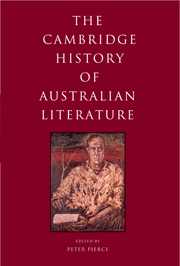Book contents
- Frontmatter
- Introduction
- FROM EUROPEAN IMAGININGS OF AUSTRALIA TO THE END OF THE COLONIAL PERIOD
- 1 Britain’s Australia
- 2 The beginnings of literature in colonial Australia
- 3 Early writings by Indigenous Australians
- 4 Australian colonial poetry, 1788–1888: Claiming the future, restoring the past
- 5 No place for a book? Fiction in Australia to 1890
- 6 Romantic aftermaths
- FROM THE LATE NINETEENTH CENTURY TO 1950
- TRAVERSES
- FROM 1950 TO NEARLY NOW
- Select bibliography
- Index
- References
2 - The beginnings of literature in colonial Australia
from FROM EUROPEAN IMAGININGS OF AUSTRALIA TO THE END OF THE COLONIAL PERIOD
Published online by Cambridge University Press: 28 May 2011
- Frontmatter
- Introduction
- FROM EUROPEAN IMAGININGS OF AUSTRALIA TO THE END OF THE COLONIAL PERIOD
- 1 Britain’s Australia
- 2 The beginnings of literature in colonial Australia
- 3 Early writings by Indigenous Australians
- 4 Australian colonial poetry, 1788–1888: Claiming the future, restoring the past
- 5 No place for a book? Fiction in Australia to 1890
- 6 Romantic aftermaths
- FROM THE LATE NINETEENTH CENTURY TO 1950
- TRAVERSES
- FROM 1950 TO NEARLY NOW
- Select bibliography
- Index
- References
Summary
Books arrived in Australia in 1788 with Governor Phillip and the first shiploads of convicts, officials and marines, as did paper, pens and ink. The last items were needed for keeping the records of the penal colony as well as maintaining communication with the mother country. In a sign of the times, also in the cargo were some boxes of type and a wooden screw press, though initially no-one could use it. Once George Hughes, a convict, began to operate the press, he was kept busy printing government notices, though the earliest surviving item is in fact a playbill, advertising a 30 July 1796 performance of Nicholas Rowe’s The Tragedy of Jane Shore (1714) at the Sydney Theatre. The first play had been performed in Australia a few years earlier, to celebrate the king’s birthday on 4 June 1789, which shows that someone had brought a copy of George Farquhar’s 1703 comedy The Recruiting Officer to Sydney.
From the beginning of Australian settlement, then, books and other items of print culture were being used not only for utilitarian purposes but also for relaxation and amusement. A surprisingly high number of early settlers could read, and by 1890 adult literacy was almost universal. This chapter will trace the importation of books, the growth of libraries and literary societies, the beginnings of local publishing and the influence of educational institutions, including mechanics’ institutes and universities. Although most books came from Britain and were by British authors, a growing number were by Americans; classical and European authors were also widely read, but few Australian ones, even though books, poems and plays were also being written in Australia from the beginning of settlement.
- Type
- Chapter
- Information
- The Cambridge History of Australian Literature , pp. 34 - 51Publisher: Cambridge University PressPrint publication year: 2009
References
- 1
- Cited by

